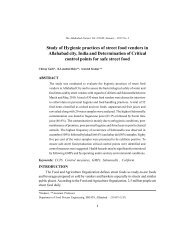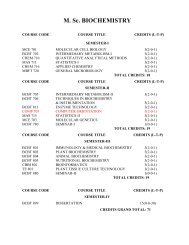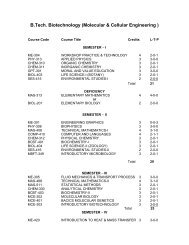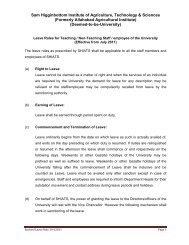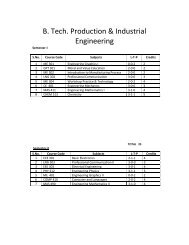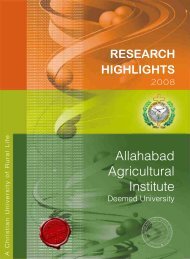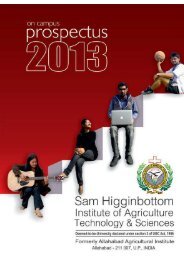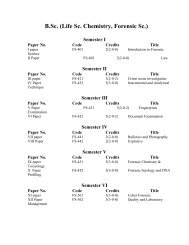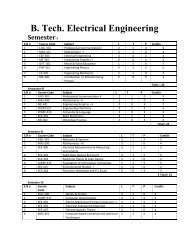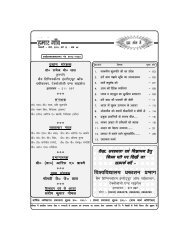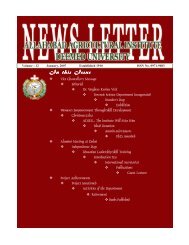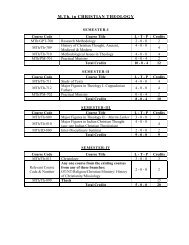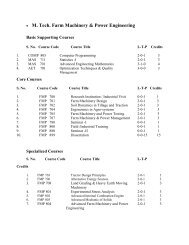Bachelor of Divinity (Two Years) - Shiats.edu.in
Bachelor of Divinity (Two Years) - Shiats.edu.in
Bachelor of Divinity (Two Years) - Shiats.edu.in
You also want an ePaper? Increase the reach of your titles
YUMPU automatically turns print PDFs into web optimized ePapers that Google loves.
<strong>Bachelor</strong> <strong>of</strong> <strong>Div<strong>in</strong>ity</strong> (<strong>Two</strong> <strong>Years</strong>)SEMESTER - ICourse Code Course Title L - T - P CreditsTBS-610 Prophetical Studies (In English/Hebrew) 3 - 0 - 0 3TBS-611 Paul<strong>in</strong>e Thought & Exegesis (In English/Greek) 3 - 0 - 0 3TTS-402 Modern Trends <strong>in</strong> Theology 3 - 0 - 0 3THS-401 History <strong>of</strong> Christianity <strong>in</strong> North and North East India 2 - 0 - 0 2TMS-525 Mission <strong>in</strong> Religious Pluralistic Context <strong>in</strong> India 2 - 0 - 0 2TCM-500 Pastoral Care & Counsel<strong>in</strong>g 3 - 0 - 0 3TRS-501 Religious & Secular Movements <strong>in</strong> India 3 - 0 - 0 3TYD-510 Yeshu Darbar Interaction-I 0 - 0 - 4 2Total Credits 19 - 0 - 4 21SEMESTER - IICourse Code Course Title L - T - P CreditsTRS-601 Advance Sanskrit (Optional) 3 - 0 - 0 3TCS-315 Introduction to Communication 3 - 0 - 0 3TBS-625 Wisdom Literature <strong>of</strong> the O.T. (In English/Hebrew) 2 - 0 - 0 2TBS-626 Johann<strong>in</strong>e Thought and Exegesis (In English/Greek) 3 - 0 - 0 3GPT-601 Indian Philosophy 2 - 0 - 0 2TTS-502 Christian Ethics 3 - 0 - 0 3TTS-503 Dalit and Tribal Theology 2 - 0 - 0 2THS-504 Christianity and Health Science <strong>in</strong> India 3 - 0 - 0 3TYD-520 Yeshu Darbar Interaction-II 0 - 0 - 4 2Total Credits 21 - 0 - 4 23SEMESTER - IIICourse Code Course Title L - T - P CreditsTBS-650 O.T. Theology 3 - 0 - 0 3TBS-651 N.T. Theology 3 - 0 - 0 3TTS-601 Indian Christian Theology 3 - 0 - 0 3TMS-601 Missiological Approaches <strong>in</strong> India 3 - 0 - 0 3TCS-405 Issues <strong>in</strong> Communications 2 - 0 - 0 2TCM-515 Christian Leadership and Spiritual Formation 3 - 0 - 0 3TRS-600 Christian Response to the People <strong>of</strong> Other Faiths 2 - 0 - 0 2TYD-605 Yeshu Darbar Interaction-III 0 - 0 - 4 2Total Credits 19 - 0 - 4 211
SEMESTER - IVCourse Code Course Title L - T - P CreditsTCM-602 Church Organization & Adm<strong>in</strong>istration 2 - 0 - 0 2TTS - 603 Asian Christian Theology 3 - 0 - 0 3THS - 608 History <strong>of</strong> Ecumenical Movement 3 - 0 - 0 3TRS - 602 Women <strong>in</strong> Religion and Society 2 - 0 - 0 2TRS - 603 Scientific Approach to Religion 2 - 0 - 0 2TYD - 610 Yeshu Darbar Interaction-IV 0 - 0 - 4 2GPT - 699 Thesis/Project 0 - 0 - 0 10Total Credits 12 - 0 - 4 242
SYLLABUSCourse Title: Prophetical Studies (In English/Hebrew)Course Code: TBS-610 Credit (3-0-0) 3Course Outl<strong>in</strong>e:[A]1. General Introduction to the Prophets/Prophecy.2. Prophetic Phenomena <strong>in</strong> Ancient near East (west Asia)3. The Rise <strong>of</strong> Prophetic Literature:• Former Prophets: Joshua – 2 K<strong>in</strong>gs.• Later Prophets: Major Prophets –Isaiah, Jeremiah, Ezekiel M<strong>in</strong>or Prophets-Hosea toMalachi.4. Prophetic M<strong>in</strong>istry prior to Monarchy.5. Prophetic M<strong>in</strong>istry dur<strong>in</strong>g Monarchical Period.6. Prophetic M<strong>in</strong>istry dur<strong>in</strong>g exilic and Post exilic periods.7. Thematic study <strong>of</strong> Prophetical understand<strong>in</strong>g <strong>of</strong> God, Righteousness, Covenant, History, S<strong>in</strong>and Punishment, Eschatology, Day <strong>of</strong> the Lord, Justice etc.8. Prophetic Phenomena <strong>in</strong> India.9. New Testament Understand<strong>in</strong>g <strong>of</strong> Prophecy <strong>of</strong> the O.T.[B]Exegetical Study on Isaiah chapter 40-55 or Amos 1-9 (either <strong>in</strong> English or Hebrew).Bibliography:K. L<strong>in</strong>dblom, Prophecy <strong>in</strong> Ancient Israel, Blackwell 1963T. H. Rob<strong>in</strong>son, Prophecy and prophets <strong>in</strong> Ancient Israel, Duckworth, London,1980.H. H., Rawley(ed), The O.T. and the Modern Study, Clarendon Press, Oxford, 1951R. E. Clements, Prophecy and Covenant, SCM, London, 1965.Westermann, C., Basic Forms <strong>of</strong> Prophetic Speech, 1967.R. J. Cogg<strong>in</strong>s, Haggar, Zechariah, Malachi (OT Guides, JSOT, Shefield, 1987).C.R. Noth, The Second Isaiah, (Clarendon Press, Oxford 1977).J. Bright, Jeremiah, (Anchor Bible, 1965).3
Course Title: Paul<strong>in</strong>e Thought and Exegesis (In English/Greek)Course Code: TBS-611 Credit (3-0-0) 3Objectives:- To have a clear understand<strong>in</strong>g <strong>of</strong> Paul’s background and realize the significance <strong>of</strong> hiswork.- To identify the Paul<strong>in</strong>e Churches and the various situations under which Paul wrote hisletters, thereby apply to our situation today.- To understand how Paul’s teach<strong>in</strong>g on various theological and doctr<strong>in</strong>al issues helpedto solve many <strong>of</strong> the Church’s problems.- To apply Paul’s teach<strong>in</strong>g <strong>in</strong> preach<strong>in</strong>g and teach<strong>in</strong>g today.Course Outl<strong>in</strong>e:1. Introduction:- The social, political and religious situation <strong>of</strong> Graeco-Roman world dur<strong>in</strong>g the time <strong>of</strong> Paul.2. Paul:- His Jewish background.- Influence <strong>of</strong> Greek culture and thought- The theology <strong>of</strong> Paul.3. Paul’s conversion – Damascus experience – mean<strong>in</strong>g and significance <strong>of</strong> that experience.4. Practical issues <strong>in</strong> Paul – e.g. Jews and non-Jews; male and female; circumcised anduncircumcised; question <strong>of</strong> unity; ecology; family relationship; attitude towards state andadm<strong>in</strong>istration; place <strong>of</strong> woman; issue <strong>of</strong> slavery, etc.5. Paul’s Christology.6. Important themes: Adam Christology – salvation, redemption and reconciliation,Justification by faith – Eschatology – New be<strong>in</strong>g, new creation – Church=body <strong>of</strong> Christ –The risen Christ=mediator.7. Issues <strong>in</strong> Paul<strong>in</strong>e theology.8. Law and Grace <strong>in</strong> Galatians.9. Exegesis (selected texts from the follow<strong>in</strong>g chapters) <strong>in</strong> English/Greek.Rom. 1, 5, 8, 9-11, 12.1Cor. 15; Eph. 1; Phil. 2, 1-11; Col 1&2.4
Bibliography:Barrett, C.K. Freedom & Obligation (SPCK, London, 1985).Baker, J.C. Paul The Apostle (Philadelphia, 1980).Bruce, F.F. Paul: Apostle <strong>of</strong> the Free Spirit (Exeter, 1977).Bornkamm, G. Paul (ET, London, 1971).Bultmann, R. The Old and New Man (ET, Richmond, 1967).Furnish, V.P. Theology and Ethics <strong>in</strong> Paul (Ab<strong>in</strong>gdon, Nashville, 1968).Hanson, A.T. The Paradox <strong>of</strong> the Cross <strong>in</strong> the Thought <strong>of</strong> Paul (Sheffield, 1987).Kaesemann, E. Perspectives on Paul (ET, London, 1971).Kim, S. The Orig<strong>in</strong> <strong>of</strong> Paul’s Religion (Grand Rapids, 1982).Richardson, P. Paul’s Ethics <strong>of</strong> Freedom (Philadelphia, 1971).Ridderbos, H. Paul: An Outl<strong>in</strong>e <strong>of</strong> his Theology (ET, London, 1977).Sanders, E.P. Paul and Palest<strong>in</strong>ian Judaism (London, 1977).Paul, the Law and Jewish People (Philadelphia, 1983).Thekkekars, M. The Face <strong>of</strong> Early Christianity (Bangalore, 1988).Zeisler, J.A. The Mean<strong>in</strong>g <strong>of</strong> Righteousness <strong>in</strong> Paul (Cambridge, 1972).5
Course Title: Modern Trends <strong>in</strong> TheologyCourse Code: TTS-402 Credit (3-0-0) 3Course Outl<strong>in</strong>e:1. The Background <strong>of</strong> Protestant thoughts on liberal and aspects <strong>of</strong> social action <strong>in</strong> 19 thcentury. Philosophical thoughts <strong>of</strong> Emmanuel Kant, Hegel, Hume and Schleiermacher.2. New Orthodoxy Approaches: Karl Barth, Burnner and Reimhold Niebuhr3. Th<strong>in</strong>kers on Existentialism: Rudolf Bultman and Paul Tillich4. Thoughts on theologies by different writers:a) Bonhoeffer’s thought on religionless society <strong>of</strong> Christiansb) Jurgen Moltmann; The Crucified God.Bibliography:Macquarries, J., Twentieth Century Religious Thought, Harper& Row, New York, 1963.Mack<strong>in</strong>tosh, H.R., Types <strong>of</strong> Modern Theology.Nicholls, Systematic Theology: Pelican Guide to modern th<strong>in</strong>k<strong>in</strong>g.Rahrst, H., the Question <strong>of</strong> God, Tr. By A.R. Wilson Coll<strong>in</strong>s, London 1969.Marty, Mart<strong>in</strong>, (ED) A handbook on Christian Theologians.6
Course Title: History <strong>of</strong> Christianity <strong>in</strong> North and North East IndiaCourse Code: THS-401 Credit (2-0-0) 2Course Outl<strong>in</strong>e:1. Introduction.2. The Beg<strong>in</strong>n<strong>in</strong>g <strong>of</strong> Christianity <strong>in</strong> India3. Location, People and Culture <strong>of</strong> the North and North East India4. The Growth and Development <strong>of</strong> Christianity <strong>in</strong> North and North East India5. Pioneer missionaries <strong>in</strong> North and North East India6. Christianity and Social Change7. Church union movements <strong>in</strong> North and North East India8. Some Major IssuesBibliography:1. Renick, M.S. Christian Missionary Movement <strong>in</strong> Northern India, Delhi: ISPCK, 20042. Jeyakumar, D. Arthur. History <strong>of</strong> Christianity <strong>in</strong> India: Selected Themes, Madurai: TTS,20003. Firth, C.B. An Introduction to Indian Church History, Madras: The CLS Press, 19924. Downs, Fredericks. History <strong>of</strong> Christianity <strong>in</strong> India: North East India <strong>in</strong> the 19 th and 20 thCenturies, Bangalore: CHAI, 20035. Hambye, E.R. History <strong>of</strong> Christianity <strong>in</strong> India: 18 th Century, Bangalore: CHAI, 19976. Zeliang, Elungkiebe. Pioneer Missionaries <strong>of</strong> North East India: Selected Missionaries, Jorhat:Author, 2003.7
Course Title: Mission <strong>in</strong> Religious Pluralistic Context <strong>in</strong> IndiaCourse Code: TMS-525 Credit (2-0-0) 2Course Outl<strong>in</strong>e:1. Religious Pluralism <strong>in</strong> the Biblei. Old Testamentii. New Testament2. Mission: Relation between Religion and Culturei. Important Features <strong>of</strong> Indian Cultureii. Indian Pluralistic Religious Culturea. H<strong>in</strong>duism, b. Islam, c. Ja<strong>in</strong>ism, d. Sikhism3. The Roman Catholic Concept <strong>of</strong> Inculturationi. The Theological Frameworkii. Attitude to Other Religious and Culturesiii. An Interpretation <strong>of</strong> Inculturationiv. Inculturation <strong>in</strong> the Church4. The Dialogue Bridge / The Inter-faith /Encounters with Dialogue5. Approaches to Religious Diversity: Soteriological Inclusivism, Exclusivism and Pluralism.7. Mission and Conversion.8. Challenges and Christian Response to Other Faiths.Bibliography:Samartha, S.J., One Christ-Many Religions, Towards a Revised Christology, New York: OrbisBooks, 1920.Aleaz K.P., The Gospel <strong>of</strong> Indian Culture, Culcutta: Punthi Pustak, 1994.Zuck, Roy B.(ed.), Vital Missions Issues Exam<strong>in</strong><strong>in</strong>g Challenges and Changes <strong>in</strong> World Evangelism,Secunderabad: OM, Books, 1998.Hedlund, Roger E. & Paul Joshua Bhakiaraj (eds.), Missiology for the 21 st Century South AsianPerspective, Delhi: ISPCK, 2004.Henry, Saroj<strong>in</strong>i, The Encounter <strong>of</strong> Faith and Sciences <strong>in</strong> Inter-Religious Dialogue, Delhi: ISPCK,2005.8
Course Title: Pastoral Care and Counsel<strong>in</strong>gCourse Code: TCM-500 Credit (3-0-0) 3Course Outl<strong>in</strong>e:I. Pastoral care- Heal<strong>in</strong>g- Reconcil<strong>in</strong>g- Guid<strong>in</strong>g- Susta<strong>in</strong><strong>in</strong>gII. Biblical understand<strong>in</strong>g <strong>of</strong> Pastoral careIII. Relationship <strong>of</strong> pastoral care and counsel<strong>in</strong>g.IV. Types <strong>of</strong> counsel<strong>in</strong>g- Marriage & family- Youth- Drug addict- Old AgeV. Approaches <strong>of</strong> counsel<strong>in</strong>g- Client- Entered- Psycho-Analysis- Gestalt- Logo-therapy etc.VI. Religions Resources (Pastoral)- The Bible- Prayer- Rites & Sacrament- Religious LiteraturesVII. Help<strong>in</strong>g others to be <strong>in</strong>volved <strong>in</strong> counsel<strong>in</strong>g- Selection- Tra<strong>in</strong><strong>in</strong>g- Appo<strong>in</strong>tmentBibliography:Cl<strong>in</strong>ebell, H., Basic Types <strong>of</strong> Pastoral Care and Counsel<strong>in</strong>g, Nashvile, Ab<strong>in</strong>gdon, 1984.Currie, Joe, The Barefoot Counsellor, Bangalore, ATC, 1976.Prashantam, P.J.,Indian case studies <strong>in</strong> Therapeutic Counsel<strong>in</strong>g, Vellore, Christian Counsel<strong>in</strong>gCenter, 1978.Taylor, H., Tend my Sheep, TEF Study guide 19 London, SPCK, 1983.9
Course Title: Religious and Secular Movements <strong>in</strong> IndiaCourse Code: TRS-501 Credit (3-0-0) 3Course Outl<strong>in</strong>e:An <strong>in</strong>troduction to the religious, social and political background <strong>in</strong> India.1) Renaissance and reaction – impact <strong>of</strong> western culture, <strong>edu</strong>cation and Christian mission – impact<strong>of</strong> science and technology – new awareness <strong>of</strong> religious identity – reaction to western impact andreconstruction <strong>of</strong> the culture heritage <strong>in</strong> India.2) Reform and renaissance movements – Brahmo Samaj and its <strong>of</strong>f shoots, theosophical society,Ramkrishna Mission, Aligarh Movement, S<strong>in</strong>gh Sabha Movement and Gurudwara Reform.3) Revival Movement - Arya Samaj, H<strong>in</strong>du Maha Sabha, Jan Sangh and thae development <strong>of</strong>Bharatiya Jatan Party, Rashtriya Swayamsevak Sangh (RSS), Vishva H<strong>in</strong>du Parisad, Shivsena,Jamaat-e-Islami H<strong>in</strong>du and Ahmadya Movement.4) Communal conflicts and controversies – communalism and its root causes, controversy overreligious centres such as Ayodhiya – local examples <strong>of</strong> communal riots.5) The role and significance <strong>of</strong> guru movements – The comb<strong>in</strong>ation <strong>of</strong> reformation and revivaldegeneration <strong>of</strong> a spiritually <strong>in</strong> the west and the missionary zeal <strong>of</strong> the guru movementorganization and activities – Ch<strong>in</strong>mayananda or Guru Shankar – Mahesh Yogi – OshoRajneesh,Satya Sai Baba and Anand Mayee Ma.6) Religious cum Secular Movement – Sarvodaya – Anand Marg – Muslim League – Neo BuddhistMovement – regional movement <strong>in</strong> India or Sri Lanka ( such as moral Rearmament Movement,Jihad Iqbal Movement and Dharma Yatra).7) a) Secular Movement - Indian National Congress, orig<strong>in</strong> and development, role <strong>in</strong> the struggle for<strong>in</strong>dependence, important leaders, the socialist policies, its split and present condition.a) Left Movement – CPI, CPI (M) and Naxalities–achievements through rule <strong>in</strong> a few states andrelationship with culture.Bibliography:Baird, Robert (ed.).Eng<strong>in</strong>eer, Asghar Ali (ed.).Kantowsky, D.Religion <strong>in</strong> Modern India, New Delhi : MausharPublication, 1981.Communal Riots <strong>in</strong> Post – Independence India,Hyderabad : Sangam Books, 1984.Sarvodaya, The other development, New Delhi : VikasPublication, 1980.Mangalawadi, V. The world <strong>of</strong> Gurus, New Delhi : Nivedit, 1987.S<strong>in</strong>gh Herbert J. Indian politics after Nehru, Bangalore : CISRS, 1967.& Rao, M.S. (eds.).S<strong>in</strong>gh, Khushwant,Gurus, Godman and God People, New Delhi : OrientLongman,1975.Thomas, M.M. & Tribal Awaken<strong>in</strong>g, Bangalore : CISRS, 1965.Taylor, R.W. (eds).Wilk<strong>in</strong>son, T.S. &Ambedkar and the Neo-Buddhist Movement, MadrasThomas M.M. :CLS, 1972.Zechriah, M. Freedom <strong>of</strong> Religion <strong>in</strong> India, Nagpur : NCCI, 199710
Course Title: Yeshu Darbar Interaction-ICourse Code: TYD-510 Credit (0-0-4) 2Course Outl<strong>in</strong>e:Introduction1. What is Yeshu Darbar Interaction.2. The Goal <strong>of</strong> Yeshu Darbar Interaction.3. The Scope <strong>of</strong> Yeshu Darbar Interaction.Activities <strong>of</strong> Yeshu Darbar Interaction1. M<strong>in</strong>istry <strong>of</strong> Preach<strong>in</strong>g:Preach<strong>in</strong>g from the Scriptures for Spiritual, Moral and Ethical upliftment <strong>of</strong> the people.2. M<strong>in</strong>istry <strong>of</strong> Feed<strong>in</strong>g:Involv<strong>in</strong>g <strong>in</strong> the Food distribution service <strong>of</strong> Yeshu Darbar M<strong>in</strong>istry.3. M<strong>in</strong>istry <strong>of</strong> Visit<strong>in</strong>g the Sick:Hospital Visitation and House Visitation.4. M<strong>in</strong>istry <strong>of</strong> Counsel<strong>in</strong>g:Youth Counsel<strong>in</strong>g, Personal Counsel<strong>in</strong>g, Family Counsel<strong>in</strong>g, Marriage Counsel<strong>in</strong>g etc. to thestudents and the families <strong>in</strong> the campus and <strong>in</strong> the neighbor<strong>in</strong>g localities.5. M<strong>in</strong>istry <strong>of</strong> Prayer:Conduct<strong>in</strong>g Prayer Meet<strong>in</strong>gs and Individual Prayer Sessions.6. M<strong>in</strong>istry <strong>of</strong> Social Action:Campus Clean<strong>in</strong>g, Plantation and Environmental Care.11
Course Title: Advanced SanskritCourse Code: TRS-601 Credit (3-0-0) 3Course Outl<strong>in</strong>e:A. Grammar, Translation and CompositionAnto<strong>in</strong>e, R: A Sanskrit Manuel Part I (The whole Book).B. Texts for detailed study: (Grammatical Questions may be asked <strong>in</strong> the study <strong>of</strong> Tests).(a) Raghu – Vansh First 57 Verses(b) Chandrapida Katha – First Twenty Pages. (Beni Madhaba, Book-Seller, Allahabad -211002).(c) Bhagavad-Gita – Chapter 4 & 12.C. History <strong>of</strong> Sanskrit LiteratureShakuntala Rao Shastri: Aspiration from A Fresh World, (Bhartiya Vidya Bhavan, Bombay).12
Course Title: Introduction to CommunicationCourse Code: TCS-315 Credit (3-0-0) 3Course Outl<strong>in</strong>e:A) Introductioni) Def<strong>in</strong>ition <strong>of</strong> Communicationii) Mean<strong>in</strong>g and scope <strong>of</strong> Communicationiii) Features <strong>of</strong> CommunicationB) The Process <strong>of</strong> Communicationi) Senderii) Messageiii) Channeliv) Receiverv) FeedbackC) Models <strong>of</strong> Communication processi) Laswell Modelii) Shannon and weaver Modeliii) Berlo's Modeliv) Gerbner's Modelv) Osgood-Schramm Modelvi) Star Modelvii) De flwur's Modelviii) Stimulus Response ModelD) Types <strong>of</strong> Communicationi) Intrapersonal Communicationii) Interpersonal Communicationiii) Group Communicationiv) Community Communicationv) Mass Communicationvi) Folk Communicationvii) Mass l<strong>in</strong>e CommunicationF) Barriers <strong>in</strong> Communicationi) Physicalii) Psychologicaliii) L<strong>in</strong>guisticiv) Culturalv) Mechanicalvi) ContextualBibliography:Appavoo J.T., Folklore for Change, TTS, Madurai, 1986.David, C.R.W., Communication <strong>in</strong> Theological Education- A Curriculum.Kumar, Keval J., Mass Communication <strong>in</strong> India-Jaico Pub. House, Bombay 1981.13
Course Title: Wisdom Literature <strong>of</strong> the Old Testament (In English/Hebrew)Course Code: TBS-625 Credit (2-0-0) 2Course Outl<strong>in</strong>e:PART-[A]1. Introduction to Wisdom, Def<strong>in</strong>ition, Scope <strong>of</strong> Old Testament wisdom. Characteristics <strong>of</strong>Old Testament wisdom.2. Wisdom Movement <strong>in</strong> the Ancient North East.3. Orig<strong>in</strong> and Development <strong>of</strong> Wisdom <strong>in</strong> Ancient Israel (dur<strong>in</strong>g monarchy)4. Critical Introduction to O.T. wisdom Literatures. (Proverbs, Job and Ecclesiastes)5. Wisdom and the Apocryphal Books. (Ecclesiasticus/Ben Sira, Wisdom <strong>of</strong> Solomon etc.).6. Type and Genre <strong>of</strong> Wisdom Literature.7. Some Important themes <strong>of</strong> wisdom literature.8. Wisdom on the New Testament.9. Wisdom and Indian Parallels.PART [B]Exegetical Study <strong>of</strong> any five chapters either on Job or Proverbs (either <strong>in</strong> English or Hebrew).Bibliography:G. Von Rad, Wisdom <strong>in</strong> Israel, SCM, London 1972.J. L, Crendshaw, Old Testament Wisdom: An Introduction, Knox Press, Atlanta, 1981.R. T. Williams, Wisdom <strong>in</strong> the ANE, IDBS 1976.D. W<strong>in</strong>ston, The <strong>of</strong> Solomon (Anchor Bible), New York, 1979.J. G. Snaith, Ecclesiasticus, (Cambridge Bible Commentary,) Cambridge, 1974.L. Stermback, Indian Wisdom and its spread beyond India.M. Monier, William, Indian Wisdom, London, 1983.H. H. Rawley (ed), Job: The Century Bible, Thomson Nelson and Sons, Ltd., 1970.W. Mckarl, Proverbs a New Approach, SCM, London, 1970.J. L. Crenshaw, Ecclesiastics; A Commentary (OTL) SCM, London, 1988.14
Course Title: Johann<strong>in</strong>e Thought and Exegesis (In English/Greek)Course Code: TBS-626 Credit (3-0-0) 3- To clearly identify the Johann<strong>in</strong>e circle and the background aga<strong>in</strong>st which he wrote hisgospel.- To realize the significance <strong>of</strong> Johann<strong>in</strong>e studies for our understand<strong>in</strong>g salvation andeternal life.- To see how John’s gospel complement to the teach<strong>in</strong>g <strong>of</strong> the synoptic.- To apply the teach<strong>in</strong>g <strong>of</strong> John to our present context.Course Outl<strong>in</strong>e:1. Introduction:i. The Johann<strong>in</strong>e community – Religious and Historical situations <strong>of</strong> the Gospel.ii. Background <strong>of</strong> the fourth gospel – Jewish, Hellenistic, Hellenistic-Jewish, Christian, andGnostic background.2. i. Authorship, provenience, and purpose.ii. The fourth gospel versus synoptic.iii. Theology <strong>of</strong> John.3. Study <strong>of</strong> sacraments <strong>in</strong> John.4. Salvation – the Jewish understand<strong>in</strong>g <strong>of</strong> salvation – the vertical view and horizontal view <strong>of</strong>the Hellenistic and the Johann<strong>in</strong>e emphasis on the present realization here and now.5. Johann<strong>in</strong>e Christology became flesh (1:14)6. Ecclesiology <strong>in</strong> the fourth gospel.7. Images and metaphors <strong>in</strong> John:i. Logos ii. Signsiii. Symbolism iv. Holy Spirit-the counsellorv. Son <strong>of</strong> God vi. Son <strong>of</strong> Man.8. (i). The “I am” say<strong>in</strong>gs – its mean<strong>in</strong>g and relevance <strong>in</strong> the Indian context(ii). How to <strong>in</strong>terpret logos <strong>in</strong> Indian context.9. Exegesis: (selected text from the follow<strong>in</strong>g chapters):Chapters: 1, 2, 5, 8, 11, 12, 15, 16, and 20.15
Bibliography:Brown, R.E. The Gospel accord<strong>in</strong>g to St. John (Doubleday, NY, II 1970).Dodd, C.H. The Interpretation <strong>of</strong> the Fourth Gospel (CUP, 1968).Barrett, C.K. The Gospel accord<strong>in</strong>g to St. John (SPCK, London, 1960).Ashton, J (ed). The Interpretation <strong>of</strong> John (Philadelphia, fortress, 1986).Bultmann, R. The Gospel <strong>of</strong> John: a Commentary (ET, Oxford, 1971).Cullman, O. The Johann<strong>in</strong>e Circle (ET, SCM, 1976).L<strong>in</strong>dars, B. The Gospel <strong>of</strong> John (NCB) (London, M,M,&S, 1981).Marsh, J. Sa<strong>in</strong>t John (SCM, 1977).Smalley, S.S. St. John: Evangelist and Interpreter (Exeter, Paternoster, 1978).Soares, Prabhu, G (ed)We Shall be Dwell<strong>in</strong>g <strong>in</strong> Him: The Gospel <strong>of</strong> John: an IndianInterpretation (Frieberg, Harder, 1984).16
Course Title: Indian PhilosophyCourse Code: GPT-601 Credit (2-0-0) 2Course Outl<strong>in</strong>e:I) Introduction: Mean<strong>in</strong>g <strong>of</strong> term, Darsana, Relation between philosophy and theology,Source <strong>of</strong> Indian Philosophy reflections.II)Early Indian Thought: Vedic Theological and philosophical reflectionUpanishads: Brahman, Atman, Jiva, Moksha, VidyaBhagavad-Gita: Nature <strong>of</strong> God, Self, Three MargasIII) Baudha Philosophy: Arya Satya (Noble Truth); Pratityasamutpada ; Anattavada ; Nirvana; Philosophical Schools.IV) Ja<strong>in</strong> Philosophy: Epistemology – Prama and Naya, SyadvadaV) Carvaka Philosophy: Epistemology – Pratyyadaksha and criticism <strong>of</strong> other source <strong>of</strong>knowledge.MetaphysicsEthicsI) Samkhya Philosophy: Cassation; Purusa, parakrita, Evolution.II) Yoga Philosophy: Astanga YogaIII) Nyaya Philosophy: Epistemology – nature <strong>of</strong> knowledge, source <strong>of</strong> knowledge.IV) Udayan’s arguments for the existence <strong>of</strong> GodV) Vaishesika Philosophy : Metaphysics – Padaratha ( Categories) Parmanukarana - Vada( Atomism)VI) Mimasa Philosophy : Epistemology – knowledge and its source, supremacy <strong>of</strong> Veda,Dharma (religious duties)VII) Vedanta Philosophy : Canon <strong>of</strong> Vedanta, Characteristic <strong>of</strong> different schools AdvaitaVedanta <strong>of</strong> Samkaraa. Brahman – Atmanb. Mayac. Jiva-Jagatd. Moksha-nature and waye. Visistadvaita <strong>of</strong> Ramanujaf. Brahman – Atman – Iswarag. Iswara, Cit, Acith. Nature <strong>of</strong>Bhaktii. Moksha-nature and waysVIII)Indian Christian Philosophy Thoughts:Satcitananda <strong>of</strong> AbhishiktanandaMaya <strong>of</strong> P.D.DevanandanBhakti <strong>of</strong> A. J. Appasami17
Bibliography:Dasgupta S. N.Devanandan, P. D.Dutta and Chatterjee,Hiryanna, M.Radhakrishnan, S.Sharma, C. D.A History <strong>of</strong> Indian Philosophy, Vols. I-V.The Concepts <strong>of</strong> Maya, YMCA, Calcutta.An Introduction to Indian Philosophy,University <strong>of</strong> Calcutta.Outl<strong>in</strong>es <strong>of</strong> Indian Philosophy, Blackie andSons, Bombay.Indian Philosophy, Vol.I & II.A Critical Survey <strong>of</strong> Indian Philosophy,Motilal Banarisdas, Delhi.18
Course Title: Christian EthicsCourse Code: TTS-502 Credit (3-0-0) 3Course Outl<strong>in</strong>e:1. Foundations <strong>of</strong> Ethicsi. Def<strong>in</strong>ition and scope <strong>of</strong> Ethics.ii. The Modes <strong>of</strong> Ethical Discourses2. Ethical <strong>in</strong> biblical Perspectivei. Old Testament, Shalom, Covenant, Law, Justice and Liberationii. New Testament: K<strong>in</strong>gdom <strong>of</strong> God, Paul<strong>in</strong>e Ethics3. Ethics and Religions4. Bio-Ethics: Fertilization, Abortion, Euthanasia/Mercy Kill<strong>in</strong>g5. Human Rights6. Government and Politics7. Poverty and Development8. Fundamentalism and Religious Harmony9. Sex, Marriage Family and Divorce10. Women’s Issues11. Ecological Crisis12. Christian Response to Technology, War, Nuclear threat.13. HIV/AIDSBibliography:Barreto Dwarte. India’s Search for Development and Social Justice.Mabry. Christian Ethics- An Introductory Reader.Beach and Neibuhr. Christian Ethics, Pp. 10-45.Smartha. The Search for New Hermeneutics <strong>in</strong> Asian Christian Theology.Norman Gothwold (ed). The Bible and Liberation Ch 1& 5.P. Devanandan & M.M Thomas. The Chang<strong>in</strong>g Pattern <strong>of</strong> Family <strong>in</strong> India.Gill. Text Book Pp. 504-515.N. Koshy. Caste <strong>in</strong> the Churches.Paul Lehmann. Transfiguration <strong>of</strong> Politics.Roland Ba<strong>in</strong>ton. Christian Attitude towards War and Peace.19
Course Title: Dalit and Tribal TheologyCourse Code: TTS-503 Credit (2-0-0) 2Course Outl<strong>in</strong>e:What is Dalit Theology, Caste System, Varnasrama Dharma etc.History <strong>of</strong> Dalits Emancipation: Religious and Social reformers.Political Movement and Th<strong>in</strong>kers: Joti Phule, Ambedkar,Dalit Panthers and different th<strong>in</strong>kers on Dalit TheologyDalit Women: Dalits <strong>of</strong> the Dalit.Bible and DalitsDalit Consciousness: Dalit theology a community vision.Exodus Experience, the question <strong>of</strong> GodDalit Christology: Cross, Holy Spirit, No People, God’s People Biography and Experiences <strong>of</strong> Dalit writers.Subaltern Consciousness <strong>of</strong> Dalits <strong>in</strong> India Social, Religious, Economic and Political Conditions andemancipation <strong>of</strong> Dalits.Tribal TheologyWho are the Tribals? Who are the Indigenous (adi.) people <strong>of</strong> India?Identity <strong>of</strong> the Tribals: Land labor and LanguageSubaltern Consciousness <strong>of</strong> Tribals <strong>in</strong> India Social, Religious, Economic and Political Conditionsand emancipation <strong>of</strong> Tribal.Bibliography:B.R. AmbedkarFernandes, W.Annihilation <strong>of</strong> caste with a reply to Mahatma Gandhi (1236) Dalit SahityaAcademy, Bangalore.Power Bases and poverty <strong>in</strong> India National Council <strong>of</strong> Churches <strong>in</strong> IndiaChennai 1987.Gutierre, G. A Theology <strong>of</strong> Liberation, S.C.M. Press Ltd. London, 1975Gurukul Lutheran Social Justice Democracy and Religions, Chennai, n.d.Theological CollegeKurien, C.T. Poverty and Development CLS Chennai, 1974.Nirmal, A.P. (ed.) Towards a common Dalit Theology Gurukul Lutheran Theological College,Chennai, n.d.Prabhakar M.E. (ed.) Towards a Dalit Theology I.S.P.C.K. Delhi, 1988.Rob<strong>in</strong>son, G. Struggle is life CLS Madras, 1988.Rob<strong>in</strong>son, G. Sid<strong>in</strong>g with the Poor CLS, Madras, 1988.Rajshekar, V.T. Christians & Dalit Liberation Dalit Sahitya Akademy, Bangalore, 1987.20
Course Title: Christianity and Health Science <strong>in</strong> IndiaCourse Code: THS-504 Credit (3-0-0) 3Course Outl<strong>in</strong>e:1. Introduction.2. Social Conditions <strong>of</strong> Indian Society <strong>in</strong> the Early Period3. Pioneer Medical Missionaries <strong>in</strong> India.4. Mission Workers <strong>in</strong> Zenanas.5. Important Medical Mission Schools and Institutions.6. Establishment <strong>of</strong> Important Medical Mission Centers: Tuberculosis, Leprosy Asylums,Mental Hospitals, Psychiatric Cl<strong>in</strong>ics, etc.7. Impact <strong>of</strong> Medical Missions on Indian Society.8. Current IssuesBibliography:1. Firth, C.B. An Introduction to Indian Church History, Madras: The CLS Press, 1992.2. Jeyakumar, D. Arthur. History <strong>of</strong> Christianity <strong>in</strong> India: Selected Themes, Madurai: TTS, 2000.3. Oddie. Social Protest <strong>in</strong> India: British Protestant Missionaries and Social Reforms 1850-1900,Columbia: SAB, 1978.4. Ingham. Reformers <strong>in</strong> India: An Account <strong>of</strong> the Work <strong>of</strong> Christian Missionaries on behalf <strong>of</strong>Social Reform 1793-1833, Cambridge University Press, 1956.5. Webster. The Christian Community & Change <strong>in</strong> 19 th Century: North India, Delhi: MacmillanCompany <strong>of</strong> India, 1976.6. ________ complete volume <strong>of</strong> History <strong>of</strong> Christianity <strong>in</strong> India, Bangalore: CHAI Publications.21
Course Title: Yeshu Darbar Interaction-IICourse Code: TYD-520 Credit (0-0-4) 2Course Outl<strong>in</strong>e:Introduction1. What is Yeshu Darbar Interaction?2. The Goal <strong>of</strong> Yeshu Darbar Interaction.3. The Scope <strong>of</strong> Yeshu Darbar Interaction.Activities <strong>of</strong> Yeshu Darbar Interaction1. M<strong>in</strong>istry <strong>of</strong> Preach<strong>in</strong>g:Preach<strong>in</strong>g from the Scriptures for Spiritual, Moral and Ethical upliftment <strong>of</strong> the people.2. M<strong>in</strong>istry <strong>of</strong> Feed<strong>in</strong>g:Involv<strong>in</strong>g <strong>in</strong> the Food distribution service <strong>of</strong> Yeshu Darbar M<strong>in</strong>istry.3. M<strong>in</strong>istry <strong>of</strong> Visit<strong>in</strong>g the Sick:Hospital Visitation and House Visitation.4. M<strong>in</strong>istry <strong>of</strong> Counsel<strong>in</strong>g:Youth Counsel<strong>in</strong>g, Personal Counsel<strong>in</strong>g, Family Counsel<strong>in</strong>g, Marriage Counsel<strong>in</strong>g etc. to thestudents and the families <strong>in</strong> the campus and <strong>in</strong> the neighbor<strong>in</strong>g localities.5. M<strong>in</strong>istry <strong>of</strong> Prayer:Conduct<strong>in</strong>g Prayer Meet<strong>in</strong>gs and Individual Prayer Sessions.6. M<strong>in</strong>istry <strong>of</strong> Social Action:Campus Clean<strong>in</strong>g, Plantation and Environmental Care.22
Course Title: Old Testament TheologyCourse Code: TBS-650 Credit (3-0-0) 3Course Outl<strong>in</strong>e:1. Orig<strong>in</strong> and Development <strong>of</strong> Old Testament Theology.2. Content and Methodology <strong>of</strong> Old Testament Theology <strong>in</strong> the writ<strong>in</strong>gs <strong>of</strong> some O.T.Theologians.3. The Theology <strong>of</strong> God as Creator (Theology <strong>of</strong> Creation & beg<strong>in</strong>n<strong>in</strong>g).a) Of the Universe.b) Of the Nature.c) Of the Human be<strong>in</strong>g.4. Thematic studies on idea <strong>of</strong> the people <strong>of</strong> God, Government, S<strong>in</strong>, Judgment, forgiveness,theodicy, bless<strong>in</strong>g, cures and promise etc.5. Exodus Tradition and liberation theology.6. Human Responsibility towards other creations. (Eco-theology).7. The significance <strong>of</strong> Sacrifices and Festivals (observances).8. The Relationship <strong>of</strong> O.T. with the N.T.9. The Relationship between Old Testament Theology and other contemporary Theology.Bibliography:W. Brueggemann, The Land (ISPCK, London, 1978).J. G. McConville, Law and Theology <strong>in</strong> Deuteronomy (JSOT Sup. 33, Sheffield, 1984).F. R. Van Develder, The Biblical Journey <strong>of</strong> Faith: The Road <strong>of</strong> the Sojourner (Fortress Press,Philadelphia, 1988).R. D. Vaux, Ancient Israel: Its life and Institutions, (DLT, London, 1961).J. B. Hurley, Man and Women <strong>in</strong> Biblical Perspective: A study <strong>of</strong> the Role Relationships andAuthority (IVP, Leicester, 1981).W. Zimmerli, Old Testament Theology <strong>in</strong> Outl<strong>in</strong>e, (T & T. Clark, Ed<strong>in</strong>burgh, 1978).G. Von Rad, OT Theology, (Vol. 1+2), (SCM, London), 1962.C. Westermann, Elements <strong>of</strong> O. T. Theology, 1982.Th. C. Vriezen, An outl<strong>in</strong>e <strong>of</strong> O.T. Theology, 1958.E. Jacob, Theology <strong>of</strong> the O.T. 1958.R.E. Clements, Old Testament Theology, A Fresh Approach, 1978.B.S. Childs, Old Testament Theology <strong>in</strong> a Canonical Context, SCM, London, 1985.Henn<strong>in</strong>g Graf Reventlow, Problems <strong>of</strong> O. T. Theology <strong>in</strong> the Twentieth Century, Philadelphia,Fortress, 1985.23
Course Title: New Testament TheologyCourse Code: TBS-651 Credit (3-0-0) 3Objectives:- To understand the core <strong>of</strong> New Testament theology and its history.- To understand the basic New Testament theologies and how they should form the basis <strong>of</strong> theChurch theology today.- To see how salvation history was cont<strong>in</strong>ued <strong>in</strong> the m<strong>in</strong>istry <strong>of</strong> the Church and the role <strong>of</strong> each<strong>in</strong>dividual today.Course Outl<strong>in</strong>e:1. Introductiona) What is theology and what is New Testament Theology?b) History <strong>of</strong> New Testament theology.2. Jesus <strong>of</strong> history and Christ <strong>of</strong> Faith.3. Jesus` teach<strong>in</strong>g on the K<strong>in</strong>gdom <strong>of</strong> God and Fatherhood <strong>of</strong> God.4. Relationship between God and man – Natural revelation and particular revelation – significance<strong>of</strong> the Christ’s event.5. Christological titles: Son <strong>of</strong> God, Son <strong>of</strong> Man, Lord etc.6. The kerygma <strong>of</strong> the early Church – the use <strong>of</strong> O.T. <strong>in</strong> the early preach<strong>in</strong>g –use <strong>of</strong> symbols andtypology.7. Metaphors used <strong>in</strong> the New testament to describe the work <strong>of</strong> Christ - Lamb <strong>of</strong> God, suffer<strong>in</strong>gservant, ransom, redemption, sanctification, adoption, the New Covenant etc.8. Man, S<strong>in</strong> and salvation.9. The Church <strong>in</strong> N.T: – the people <strong>of</strong> God – the body <strong>of</strong> Christ etc.10. K<strong>in</strong>gdom <strong>of</strong> God and k<strong>in</strong>gdom values.11. The Sacraments.12. Nature and work <strong>of</strong> the Holy Spirit.13. Eschatology – last judgment and summ<strong>in</strong>g up <strong>of</strong> all th<strong>in</strong>gs – present and f<strong>in</strong>al victory.24
Bibliography:Stauffer, E. NT Theology (SCM, London, 1955).Hunter, A.M. Introduction to NT Theologies (SCM, London, 1963).Richardson, A. An Introduction to NT Theology (SCM, London, 1977).Bultmann, R.Theology <strong>of</strong> the New Testament (SCM, London, 1971 2vols).Cullman, O. The Christology <strong>of</strong> the New Testament (SCM, London, 1963).Ladd, G.E.Conzelmann, H.Schnackenburg, R.Theology <strong>of</strong> the New Testament (Lutterworth press, London,1977).An Outl<strong>in</strong>e <strong>of</strong> the Theologies <strong>of</strong> the New Testament (SCM,London, 1969).New Testament Theology Today.25
Course Title: Indian Christian TheologyCourse Code: TTS-601 Credit (3-0-0) 3Course Outl<strong>in</strong>e:i) IntroductionMethodological issues <strong>in</strong> India Christian theology the authority <strong>of</strong> the scripture from Indiantheological perspective: Such as Pramanas: Sruti, Anubhava and Anumans.ii) Thoughts and reflection <strong>of</strong> scholars to other faithsRaja Ram Mohan Roy, Mahatma Gandhi and Keshub Chunder Seniii) (a) Syrian and protestant traditions(b) Some missionaries –Who adopted different Missionary Methods:Robert De Nobili, J.N. Farquhar,A.G. Hogg and Kaj Baago,iv) The Rational approach to other faith Nehemiah Goreh.v) The theologians who contributed on advaitic thoughts: Brahma Bandhab Upadhyaya, MarkSunder Rao. Jules Monchan<strong>in</strong>.vi) Personalistic impact and thoughts on Christian theology: Sadhu Sunder S<strong>in</strong>gh, A.J. Apposamyand Surjit S<strong>in</strong>gh.vii) Theology <strong>of</strong> the new creation: Pandipeddi Chenchiahviii) Christology <strong>of</strong> the Spirit: Vengal Chakkariix) Interfaith dialogue: Paul D. Devanandan, Abhishiktananda, Raymond Panikkar, Stanley J.Samartha.x) Churches Christianity: Manilal C. Parekh, K. Subba Raoxi) Action oriented theology: M.M. Thomas, S. Kappen, J.R. Chandran, Paulos Mar Gregaries.Bibliography:Abhishiktananda, Swami, H<strong>in</strong>du Christian Meet<strong>in</strong>g Po<strong>in</strong>tAmalados et al. (eds.), Theologiz<strong>in</strong>g <strong>in</strong> IndiaAppasamy, A.J., Christianity as Bhakti MargaKulandran, S., A Comparative Study <strong>of</strong> the Doctr<strong>in</strong>e <strong>in</strong> Christianity and H<strong>in</strong>duism.Panikkar, R., The unknown Christ <strong>of</strong> H<strong>in</strong>duism.26
Course Title: Missiological Approaches <strong>in</strong> IndiaCourse Code: TMS-601 Credit (3-0-0) 3Course Outl<strong>in</strong>e:1. The Development <strong>of</strong> Missiology – The Goal <strong>of</strong> Missiology2. Culture and Mission: Colonialist Times and Beyond.3. Evangelization <strong>of</strong> India <strong>in</strong> Urbanization and Modernity.4. Church’s Mission <strong>in</strong> Ecology5. The Contribution <strong>of</strong> the Church <strong>in</strong> Socio-Economic, Religio-Political Reality.6. Missiological Approaches to the Tribals <strong>in</strong> India.7. Mission among the Tribals and Dalit Women.8. Christian Response to the Reality <strong>of</strong> Caste.9. Reflection on Community Violence.Bibliography:Mattam, Joseph & Krickw<strong>in</strong> C. Marak (eds.), Missiological Approaches <strong>in</strong> India Retrospect andProspect, Mumbai: St. Pauls, 1999.Mathew, C.V(ed.), Mission <strong>in</strong> Context: Missiological Reflections essays <strong>in</strong> honor <strong>of</strong> Roger & JuneHedlund, Delhi: ISPCK, 2003.Hrangkhuma, F. & Sebastian C.H. Kim (eds.), The Church <strong>in</strong> India: Its Mission Tomorrow, Delhi:ISPCK, 1999.Aykara, Thomas, A Missiology for Third Millennium, A Contextualized Mission Theology,Bangalore, Dharmaram Publications, 1997.Jonathan, F.C., Millennium Mission: The Issues: M<strong>in</strong>isterial Formation, Delhi: ISPCK, 2001.27
Course Title: Issues <strong>in</strong> CommunicationCourse Code: TCS-405 Credit (2-0-0) 2Course Outl<strong>in</strong>e:A) History <strong>of</strong> Mass Mediai) Cave Pa<strong>in</strong>t<strong>in</strong>gii) Age <strong>of</strong> Moralityiii) Invention <strong>of</strong> Writ<strong>in</strong>giv) Scriptsv) Pr<strong>in</strong>t<strong>in</strong>gvi) Telegraphvii) Electronic MediaB) Understand<strong>in</strong>g <strong>of</strong> Mass Mediai) Def<strong>in</strong>ition <strong>of</strong> Mass Mediaii) Mean<strong>in</strong>g <strong>of</strong> Mass Mediaiii) Nature <strong>of</strong> Mass MediaC) Types <strong>of</strong> Mediai) Radioii) Televisioniii) Pr<strong>in</strong>t Media and Newspapersiv) C<strong>in</strong>emav) Computersvi) Internetvii) SatelliteD) Mass Media Issuesi) Uneven Information flowii) Media as Transnational Market and Globalization.iii) Representation <strong>of</strong> Various Groups <strong>in</strong> Media (women, children, miority)iv) Role <strong>of</strong> Advertis<strong>in</strong>g <strong>in</strong> Mass Mediav) Violence <strong>in</strong> the MediaE) Functions <strong>of</strong> Mass Mediai) Social use <strong>of</strong> Mass Mediaii) Traditional MediaBibliography:Sandra J. Rokeach., Media Audience & Social Structure, SAGE Pub. London, 1986.Berlo, David K., The Process <strong>of</strong> Communication Holt, R<strong>in</strong>ehart, W<strong>in</strong>ston London, 1960.Lowery Shearon., Milestones <strong>in</strong> Mass Communication, Research: Media Effects, Longman, NY,1983.Schramm, Wilbur.,Big Media and Little Media.28
Course Title: Christian Leadership and Spiritual FormationCourse Code: TCM-515 Credit (3-0-0) 3Course Outl<strong>in</strong>e:I. Introductioni. Mean<strong>in</strong>g and Def<strong>in</strong>ition <strong>of</strong> the Terms.ii. The Nature and Purpose <strong>of</strong> Christian LeadershipII. Theories and Styles <strong>of</strong> Leadershipi. Sociology and Christian Leadershipii. Leadership <strong>in</strong> Bible Times.iii. Pr<strong>in</strong>ciples <strong>of</strong> Leadershipiv. Style <strong>of</strong> LeadershipIII. Practice <strong>of</strong> Leadershipi. Shared Leadershipii. Initiat<strong>in</strong>g a Leadership Explosioniii. Manag<strong>in</strong>g a Leadership Explosioniv. Social Action and EvangelismIV. The Leader’s Visioni. Change and ConflictV. Leadership Development <strong>in</strong> Community, Church and Society.VII. Leadership and Plann<strong>in</strong>gi. Types <strong>of</strong> Plann<strong>in</strong>gii. Implementation <strong>of</strong> Plann<strong>in</strong>gBibliography:Devadason, E.D., Christian Law <strong>in</strong> India, Madras, DSI, PublicationK<strong>in</strong>g, Philip, Leadership Explosion, Hodder and Sloughton, London, 1987.Niebuhr, H.R., The Purpose <strong>of</strong> the Church and its M<strong>in</strong>istry.Rudg, Peter, M<strong>in</strong>istry and ManagementThanasamy, D.A, Equipp<strong>in</strong>g the Clergy for tra<strong>in</strong><strong>in</strong>g the Laity.29
Course Title: Christian Response to the People <strong>of</strong> Other FaithsCourse Code: TRS-600 Credit (2-0-0) 2Course Outl<strong>in</strong>e:[A] General Introduction1. How the Christianity has f<strong>in</strong>ality <strong>of</strong> Jesus Christ with his uniqueness and decisiveness amongother faiths.2. The last commandment <strong>of</strong> Jesus Christ Mathews 28: 18-20 go and baptize all the people and makethem disciples. What is the reaction <strong>of</strong> the people <strong>of</strong> other faith <strong>in</strong> their own context.3. What is the experience <strong>in</strong> Christianity <strong>of</strong> other faiths? Can we have a peaceful relationship withjustice and <strong>in</strong>tegrity with the people <strong>of</strong> other faiths?4. What was the early missionary method <strong>of</strong> preach<strong>in</strong>g the gospel to the people <strong>of</strong> other faiths?5. There is a need <strong>of</strong> mutual understand<strong>in</strong>g to make religious and philosophical thoughts clear toeach other.6. Response <strong>of</strong> the pastors can not be conf<strong>in</strong>ed to congregation alone but to the community at largefor the development <strong>of</strong> social Programmes and pastoral response to <strong>in</strong>ter-religious marriages.[B] Different perspectives to look at the people <strong>of</strong> other faiths:1. Biblical, Theological, Philosophical and historical perspective.2. What is other people's response to Christianity? What is the role <strong>of</strong> Christianity <strong>in</strong> response toSocial Economic, Political, National and at International Levels3. Dialogical dimensions and <strong>in</strong>clusive response to the people <strong>of</strong> other faithsContent <strong>of</strong> the Course1. Major Religions: Similarities and dissimilarities2. Biblical response to the people <strong>of</strong> other faiths how does Israelite response to the people <strong>of</strong>other faiths <strong>in</strong> O.T.: For example promise and prophecies <strong>in</strong> Genesis 9, Isaiah 19:45, Jonah 1-4,Amos 1, 2 and 9.N. T. Response <strong>of</strong> Jesus to the People <strong>of</strong> Other Faith: response <strong>of</strong> Paul to Judaism, other faithsand their culture: Peter, Cornelius and Council <strong>of</strong> Jerusalem.Biblical Reference <strong>in</strong> response to salvation <strong>of</strong> allActs 4: 11-12, 10: 35-36, 17: 22-31; I Cor<strong>in</strong>thians 5: 9-12, 9: 20, 21: 10, 27: 32-33II Cor<strong>in</strong>thians 6: 14; Philipians 2: 3-6; I Timothy 2: 3-63. What is Historical, Theological and Philosophical background <strong>of</strong> Christianity <strong>in</strong> response to thepeople <strong>of</strong> other faiths:The Arrival <strong>of</strong> Missionaries and missionary conferences: Ed<strong>in</strong>burg, Jerusalem and Tambaram.Ashrams, W.C.C. Roman Catholics and Response to other Faiths, the Dialogue, CISRS etc.30
4. Christian th<strong>in</strong>kers & models for response to other faiths:a) Polemical Model: Karl Barth and Kraemerb) The Strategic Model: Robert de Nobili Ziegenbalg,Father Stevents and othersc) The Fulfillment and Synthesis Model: J. N. Farquahar, Saunders, Vatican II,Swami Abhishiktananda etc.d) The Syncretism Syncretistic Model: K.C. Sen and P.C. Mozoomdare). The Re-conception Model:W.E. Hock<strong>in</strong>gf). The Anonymous Model <strong>of</strong> Christianity:g). The Copernican Revolution Model:h). Dialogue & Truth ClaimsKarl Rahner and Raymond Pa<strong>in</strong>kkarJohn HickS.J. Samartha etc.i). Bede Griffiths and J.R. Chandranj). Mean<strong>in</strong>g <strong>of</strong> the term: Uniqueness;k). Decisiveness, Redemption <strong>in</strong> Christ and Fulfillmentl). Different Thoughts on Indigenous Theology and worship Patternsm). Involvement <strong>of</strong> Christians <strong>in</strong> Festivals <strong>of</strong> Other Faiths.n). Involvement <strong>of</strong> Christians <strong>in</strong> social and political actions with the people <strong>of</strong> other faiths.M.M. Thomas and P.D. Devanandan etc.Bibliography:Allen, E.L.,Aryarajah, S. WesleyE.C. Dewick,S.J. Samartha,S.J. Samartha,Henrik Kraemer,Christianity among the Religions,London, 1960The Bible and People <strong>of</strong> Other Faiths,Geneva, W.C.C., 1985.The Christian Attitude to other ReligiousCambridge University Press, 1953Courage for DialogueWCC, 1981Liv<strong>in</strong>g Faiths and Ecumenical MovementGeneva, WCC 1971.The Christian Message <strong>in</strong> a Non-Christian World IMC Ed<strong>in</strong>burghHouse Press 1938.31
Course Title: Yeshu Darbar Interaction-IIICourse Code: TYD-605 Credit (0-0-4) 2Course Outl<strong>in</strong>e:Introduction1. What is Yeshu Darbar Interaction?2. The Goal <strong>of</strong> Yeshu Darbar Interaction.3. The Scope <strong>of</strong> Yeshu Darbar Interaction.Activities <strong>of</strong> Yeshu Darbar Interaction1. M<strong>in</strong>istry <strong>of</strong> Preach<strong>in</strong>g:Preach<strong>in</strong>g from the Scriptures for Spiritual, Moral and Ethical upliftment <strong>of</strong> the people.2. M<strong>in</strong>istry <strong>of</strong> Feed<strong>in</strong>g:Involv<strong>in</strong>g <strong>in</strong> the Food distribution service <strong>of</strong> Yeshu Darbar M<strong>in</strong>istry.3. M<strong>in</strong>istry <strong>of</strong> Visit<strong>in</strong>g the Sick:Hospital Visitation and House Visitation.4. M<strong>in</strong>istry <strong>of</strong> Counsel<strong>in</strong>g:Youth Counsel<strong>in</strong>g, Personal Counsel<strong>in</strong>g, Family Counsel<strong>in</strong>g, Marriage Counsel<strong>in</strong>g etc. to thestudents and the families <strong>in</strong> the campus and <strong>in</strong> the neighbor<strong>in</strong>g localities.5. M<strong>in</strong>istry <strong>of</strong> Prayer:Conduct<strong>in</strong>g Prayer Meet<strong>in</strong>gs and Individual Prayer Sessions.6. M<strong>in</strong>istry <strong>of</strong> Social Action:Campus Clean<strong>in</strong>g, Plantation and Environmental Care.32
Course Title: Church Organization and Adm<strong>in</strong>istrationCourse Code: TCM-602 Credit (2-0-0) 2Course Outl<strong>in</strong>e:1. The importance <strong>of</strong> Church Organization and Adm<strong>in</strong>istration to the life and mission <strong>of</strong> the church.2. Mean<strong>in</strong>g <strong>of</strong> Adm<strong>in</strong>istration <strong>in</strong> relation to Pastoral work.Different Patterns <strong>of</strong> Church Organization: Episcopal, Congregational etc.3. Function<strong>in</strong>g <strong>of</strong> the local Church: Church member, Church committee, Church f<strong>in</strong>ances, andChurch property.4. Arrangement <strong>of</strong> Meet<strong>in</strong>gs, Conferences, Rules <strong>of</strong> the <strong>of</strong>fices <strong>of</strong> Chairperson, Secretary andTreasurer.5. Account<strong>in</strong>g <strong>in</strong> Church Organization: Income and Expenditure6. Legal matters: Law applicable to religious matters.7. Correspondence: M<strong>in</strong>utes writ<strong>in</strong>g, Writ<strong>in</strong>g <strong>of</strong> Formal and Informal Letters.Bibliography:Devadason, E.D., Christian Law <strong>in</strong> India, Madras, DSI Publications,Devasahayam (ed.), Reth<strong>in</strong>k<strong>in</strong>g Christianity <strong>in</strong> India, Madras, CLS,Steward, W., M<strong>in</strong>istry and Management.33
Course Title: Asian Christian TheologyCourse Code: TTS-603 Credit (3-0-0) 3Course Outl<strong>in</strong>e:1. Korean M<strong>in</strong>jung Theology2. Symbolism and its Relevance to Church <strong>in</strong> Malaysia3. Cultic Images and Thai Context4. Burma-Myanmar- Known as Land <strong>of</strong> Pagodas <strong>in</strong> Relation to a Christian Response.5. Religions and Church <strong>in</strong> S<strong>in</strong>gapore.6. Ch<strong>in</strong>ese Folk Religions, Contextualization and Theological Transformation <strong>in</strong> Ch<strong>in</strong>eseChristianity.7. Filip<strong>in</strong>o Culture and Contextualization <strong>of</strong> the Gospel Message <strong>in</strong> Philipp<strong>in</strong>es.8. Buddhism and Yigwan Dao <strong>in</strong> Taiwan and Christian Response.9. The Encounter Between Indigenous People and In-Com<strong>in</strong>g Church <strong>in</strong> Indonesia.10. A Pakistani Perspective <strong>in</strong> Socio-Religious Realities.11. Sri Lankan Perspective and Christian Response.12. A Quest <strong>in</strong> Religions for Peaceful Coexistence <strong>in</strong> Bangladesh13. Japan: Pa<strong>in</strong> <strong>of</strong> God.14. Other Contextual Theologies <strong>in</strong> Asia.Bibliography:Samson Prabhakar (ed). Inter Cultural Asian. Theological Methodologies, An Exploration. (SouthAsia Theological Research Institute, 2002).John Parratt (ed). An Introduction to Third World Theologies. (Cambridge University Press, 2004).Kosuke Koyami. Water Buffalo Theology, (London: SCM Press Ltd. 1974).Ed. Vimal Tirimanna. Asian Faces <strong>of</strong> Christ (Bangalore: Asian Trad<strong>in</strong>g Corporation, 2005).Michael Amaladoss, S.J. The Asian Jesus (New Delhi: ISPCK, 2005).Asia Journal <strong>of</strong> Theology, Vol.14. No.1, April 2000Asia Journal <strong>of</strong> Theology, Vo.l5. No.1, April 2001Asia Journal <strong>of</strong> Theology, Vol. 16, No.2, October 2002Asia Journal <strong>of</strong> Theology, Vol. 21, No.1, April 2007Vidya Sagar J. Dogar. Rural Christian Community <strong>in</strong> North West India.Nicholas Standaert. Handbook <strong>of</strong> Christianity <strong>in</strong> Ch<strong>in</strong>a.Pieris S.J.A. An Asian Theology <strong>of</strong> Liberation (Maryknoll: Orbis Book, 1988).Smartha. The Search for New Hermeneutics <strong>in</strong> Asian Christian Theology.Scott W. Sunquist. A Dictionary <strong>of</strong> Asian Christianity.34
Course Title: History <strong>of</strong> Ecumenical MovementCourse Code: THS-608 Credit (3-0-0) 3Course Outl<strong>in</strong>e:1. Introduction.2. Ecumenical Beg<strong>in</strong>n<strong>in</strong>gs <strong>in</strong> the 17 th and 18 th centuries3. Ecumenical Development <strong>in</strong> mission perspectives from the 18 th century to 19104. Church Union Movement and the growth <strong>of</strong> modern ecumenism5. Church Union Movements <strong>in</strong> India6. Some Major IssuesBibliography:1. Rouse, Ruth and Stephen Neill. A History <strong>of</strong> the Ecumenical Movement, Geneva: WWC,19862. Philip, T.V. Ed<strong>in</strong>burgh to Salvador, Delhi: ISPCK, 19993. Hogg, William Richey. Ecumenical Foundations, N.Y.: Harper and Brothers Publishers,19524. Fey, Harold E. The Ecumenical Advance, London: SPCK, 19705. Snaitang, O.L. A History <strong>of</strong> Ecumenical Movement: An Introduction, Bangalore:BTESSC/SATHRI, 2007.35
Course Title: Women <strong>in</strong> Religion and SocietyCourse Code: TRS-602 Credit (2-0-0) 2Objectives:1. To develop gender sensitivities <strong>in</strong> our theological <strong>edu</strong>cation and vocational discourses2. To develop Indian perspective <strong>in</strong> Women studies3. To have a comprehensive knowledge <strong>of</strong> Indian Religious Traditions, Society and Issues andhow women are positioned <strong>in</strong> themCourse Outl<strong>in</strong>e:Section I1. Women <strong>in</strong> H<strong>in</strong>du Religious Tradition (Vedic Age)2. Women <strong>in</strong> H<strong>in</strong>du Religious Tradition (Puranic Age)3. Women <strong>in</strong> Muslim Religious Tradition4. Women <strong>in</strong> Buddhist Religious Tradition5. Women <strong>in</strong> Ja<strong>in</strong>a Religious Tradition6. Women <strong>in</strong> Sikh Religious Tradition7. Women <strong>in</strong> Primal Religious TraditionSection II1. Place <strong>of</strong> Women <strong>in</strong> Manudharmashastra2. Sha ‘at and Muslim women3. The concept <strong>of</strong> Nirvana and women (Buddhism)4. Ahimsa and women (Ja<strong>in</strong>ism)5. Sikh worship and women’s participation6. Shamanism and women <strong>in</strong> Primal Religions7. Dalit womenSection III1. Women and Human Right Issues2. Women and caste system3. Women and Religious fundamentalism4. Women and Religious conversion5. Women and Religious Pluralism6. Women and Religious Prostitution7. Women and Communal Violence36
Course Title: Scientific Approach to ReligionCourse Code: TRS: 603 Credit (2-0-0) 2Course Outl<strong>in</strong>e:1. Objectivesa) To equip Students with the knowledge <strong>of</strong> Science and Religionsb) To study Science and Theology Separately and then <strong>in</strong>tegrat<strong>in</strong>g them together.c) To analyze this subject with various <strong>in</strong>terpretation.d) To <strong>in</strong>terpret the modern day technology <strong>in</strong> spiritual understand<strong>in</strong>g1. Impact <strong>of</strong> Technological Revolution on Society and Religious ResponseElementary understand<strong>in</strong>g <strong>of</strong> Basic Science (Physics, Chemistry, Biology, Biotechnology,Technology etc), Impact <strong>of</strong> Technology on Society (the Poor, Marg<strong>in</strong>alized, Oppressed andWomen) and its <strong>in</strong>terpretation <strong>in</strong> the light <strong>of</strong> Biblical writ<strong>in</strong>g2. Quest for Unity: Science and Religion.Contemporary views <strong>of</strong> the relationship between the methods <strong>of</strong> science and those <strong>of</strong> religion asproposed by Ian Barbour3. Science, Cosmology and TheologyBig bang Theory, Darw<strong>in</strong> Evolution Theory, Intelligent Designer Theory, Theology <strong>of</strong> Creation4. Biotechnology and Genetic Eng<strong>in</strong>eer<strong>in</strong>g: Scientific and Theological PerspectiveStem Cell, Surrogate Mother, Clon<strong>in</strong>g (Human, Animal, Plants), Genetics, TheologicalUnderstand<strong>in</strong>g, Bioethics5. Ecological Crisis: Scientific Technology and Religious IndictmentUnderstand<strong>in</strong>g <strong>of</strong> ecology and the factors responsible for ecological crisis, Indian religioustradition about nature with special reference to H<strong>in</strong>duism and the current, Ecological crisis <strong>in</strong>India, An <strong>in</strong>sight <strong>in</strong>to God’s Creation account <strong>in</strong> Genesis and various theological approachestowards Ecology, Pr<strong>in</strong>ciples for ecclesial eco praxis with reference to the div<strong>in</strong>e task <strong>of</strong>stewardship <strong>in</strong> the Genesis Creation Account.6. Religious and Philosophical View <strong>of</strong> Nature by Em<strong>in</strong>ent Scientists <strong>in</strong> Various CenturiesFamous Scientists and their Views about Nature [Nicholas Copernicus (1473-1543), GalileoGalilei (1564-1642), Johannes Kepler (1571-1630), Blaise Pascal (1623 – 1662), Isaac Newton(1642-1727), Michael Faraday (1791-1867), Albert E<strong>in</strong>ste<strong>in</strong> (1879-1955), Charles Darw<strong>in</strong>],Nature <strong>in</strong> Philosophical Understand<strong>in</strong>g [Classical concept <strong>of</strong> the universe and human nature,Medieval concept <strong>of</strong> nature and human nature, Liberal concept <strong>of</strong> the universe and human nature,Green concept <strong>of</strong> the universe and human nature]37
Bibliography:Barbour, Ian G. Nature Human Nature and GodM<strong>in</strong>neapolis: Fortress Press, 2002Nalunnakkal, George. Mathew Green Liberation: Towards an Integral EcotheologyDelhi: ISPCK/NCCI, 2004Capra, Fritj<strong>of</strong> The Turn<strong>in</strong>g Po<strong>in</strong>t: Science, Society and the Ris<strong>in</strong>g CultureNew York: Simon and Schuster, 1982Berry, Thomas The Dream <strong>of</strong> the Earth San Francisco: Sierra Club Books, 1998.Eliade, M. The Sacred and the Pr<strong>of</strong>ane: The Nature <strong>of</strong> Religion, trans. W.R. Trask.New York: Harcourt, Brace & World, 1959.Grudem, Wayne Systematic Theology: An Introduction to Biblical Doctr<strong>in</strong>eGrand Rapids: Michigan, 1994.Pamplany, August<strong>in</strong>e Theological Mysteries <strong>in</strong> Scientific PerspectiveBangalore: Asian Trad<strong>in</strong>g Cooperation, 2005.Rolston, Holmes Environmental Ethics: Duties to and Values <strong>in</strong> the Natural World, Philadelphia:Temple University Press.Srivastav, K.K Environmental Educational: Pr<strong>in</strong>ciples, Concepts and ManagementDelhi: Kanishka, 2004.Srivastava, D.C. (ed.), Read<strong>in</strong>gs <strong>in</strong> Environmental Ethics: Multidiscipl<strong>in</strong>ary Perspective Jaipur:Rawat, 2005.Watson, Rajula Annie Development and Justice: A Christian Understand<strong>in</strong>g <strong>of</strong> Land Ethics Delhi:ISPCK, 2004Sharma, Ram Nath. Philosophy <strong>of</strong> Religion, Kedarnath Ramnath,Delhi, 1988.Hummel, Charles. E. The Galileo Connection,Inter Varsity Press, 1986.Drake, Still. Mon, Discoveries and op<strong>in</strong>ions <strong>of</strong> Galileo,Double Day Anchor Books, 1957.38
Course Title: Yeshu Darbar Interaction-IVCourse Code: TYD-610 Credit (0-0-4) 2Course Outl<strong>in</strong>e:Introduction1. What is Yeshu Darbar Interaction?2. The Goal <strong>of</strong> Yeshu Darbar Interaction.3. The Scope <strong>of</strong> Yeshu Darbar Interaction.Activities <strong>of</strong> Yeshu Darbar Interaction1. M<strong>in</strong>istry <strong>of</strong> Preach<strong>in</strong>g:Preach<strong>in</strong>g from the Scriptures for Spiritual, Moral and Ethical upliftment <strong>of</strong> the people.2. M<strong>in</strong>istry <strong>of</strong> Feed<strong>in</strong>g:Involv<strong>in</strong>g <strong>in</strong> the Food distribution service <strong>of</strong> Yeshu Darbar M<strong>in</strong>istry.3. M<strong>in</strong>istry <strong>of</strong> Visit<strong>in</strong>g the Sick:Hospital Visitation and House Visitation.4. M<strong>in</strong>istry <strong>of</strong> Counsel<strong>in</strong>g:Youth Counsel<strong>in</strong>g, Personal Counsel<strong>in</strong>g, Family Counsel<strong>in</strong>g, Marriage Counsel<strong>in</strong>g etc. to thestudents and the families <strong>in</strong> the campus and <strong>in</strong> the neighbor<strong>in</strong>g localities.5. M<strong>in</strong>istry <strong>of</strong> Prayer:Conduct<strong>in</strong>g Prayer Meet<strong>in</strong>gs and Individual Prayer Sessions.6. M<strong>in</strong>istry <strong>of</strong> Social Action:Campus Clean<strong>in</strong>g, Plantation and Environmental Care.39



